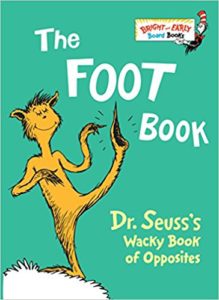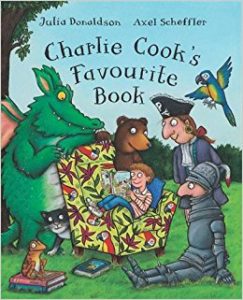In preparation for Picture Books as Mentor Texts (a session I presented this summer!), I searched for different organizational structures in fiction and found this gem! First, I was attracted to the pictures because they provided an odd sense of childhood comfort. Why? I finally realized that it was because it’s by the same duo (Julia Donaldson and Axel Scheffler) who wrote The Gruffalo!
Why I Finished It:
This read is a unique journey through picture book paradise! Charlie is reading his favorite book about pirates, the pirate is reading his favorite book, a fairy tale, this continues for eleven books! And the books are all different genres! My teacher’s head started spinning on THE FIRST read, so I began flipping quickly to see all the different books presented in this one book. I honestly tried to stop myself but I just couldn’t! Once I saw all the books presented and let my mind wander about all the ways this could be used in a classroom and library, I went back through and read the story for enjoyment. It’s definitely a winner!
Who I Would Give It To:
Elementary teachers, you NEED this one for the first week of school. You just do! This is a perfect book to introduce your classroom library and different genres. It is a great read-aloud for parents and tots too!
Integration Ideas:
Writing Mentor Text: Organization and Predictions
One way that authors organize fictional text is with circular stories. Circular stories have a character going out on a journey but ending right where they began. Many times they are humorous because they end up where they began after their initial goal didn’t work. In this book, Charlie begins reading his favorite book on a chair, goes on a favorite book journey and ends up back in his chair reading his favorite book.
I have seen other teachers use circular texts as mentor texts for students to write their own circular story, but I prefer to analyze the structure and have students make predictions. Circular stories are a great way to get younger students to begin making predictions. After two times of Charlie Cook’s characters finding their favorite book, students can begin to make their own predictions. What do you think will happen? What do you think _______ favorite book will be?
Universal Themes: Cycles
For those of you who like to teach thematically and cross-curricular, this is a great time to teach cycles. Students can be studying cycles of seasons and life-cycles while learning about circular stories. At the same time, students can be studying circles in math, as well as fact families. 
Genre Study
One reason I really enjoyed this book is that it introduces a few different genres. At the beginning of the year, it is so important to show students what books are in the classroom and expose them to a variety of genres. I have never had a mentor text that could help introduce the genres…until now! Once we have read through the book once, I will reread the story to the students, but we will stop and discuss each of the character’s favorite books. We will talk briefly about the genre and what to expect from that type of genre. Then I will let students self-explore the different books and genres in the classroom.
Writing Mentor Text: Idea Development
 We can’t forget the obvious lesson here, which would be adding this to developing seed ideas in a Writers’ Workshop! This book is all about the characters’ favorite books, so let students think about their favorite books and the story to go with it. I always share my experience with my oldest son, Jack, and his favorite book. When he was a child he LOVED the Foot Book by Dr. Suess. We read this book so many times, that I hid it from him. Regardless of where I put it, he always found it. It was like he had a tracking device on the thing! I finally got rid of the book altogether. About a month later, he went to a book exchange at daycare. You guessed it! He returned home with THE FOOT BOOK! I cringed and asked them at school, and they said it was completely random.
We can’t forget the obvious lesson here, which would be adding this to developing seed ideas in a Writers’ Workshop! This book is all about the characters’ favorite books, so let students think about their favorite books and the story to go with it. I always share my experience with my oldest son, Jack, and his favorite book. When he was a child he LOVED the Foot Book by Dr. Suess. We read this book so many times, that I hid it from him. Regardless of where I put it, he always found it. It was like he had a tracking device on the thing! I finally got rid of the book altogether. About a month later, he went to a book exchange at daycare. You guessed it! He returned home with THE FOOT BOOK! I cringed and asked them at school, and they said it was completely random.
Have students jot down these stories or even develop them if you have time.
Text-to-Text Connections
Have students read other circular stories and discuss how the author handled the story structure. Have students make predictions and think about why the author made the choices (s)he did. Here is a list of other circular stories.
How do you teach circular stories?







Leave a Reply